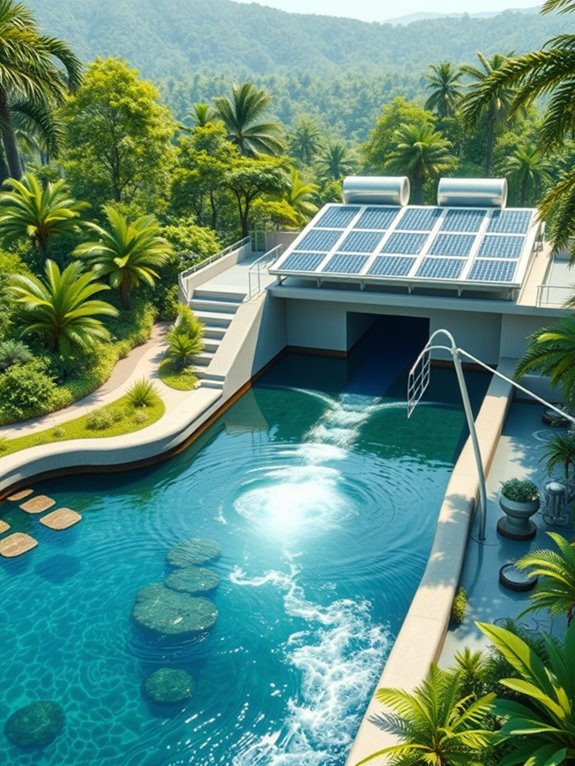Water treatment plants aren’t bad for the environment—it’s a common myth. In fact, they play an essential role in protecting ecosystems by removing harmful contaminants from wastewater. These facilities recycle and manage resources, ensuring that water is safe for consumption while reducing pollution in natural bodies. Misunderstandings often overshadow the benefits. Explore how innovations in technology are enhancing sustainability and improving water quality.
Understanding Water Treatment Plants and Their Purpose

Water treatment plants play an essential role in ensuring the safety and quality of the water you drink and use daily. They process and purify raw water from sources like rivers and lakes, removing contaminants and harmful substances.
This process involves several steps, including coagulation, sedimentation, filtration, and disinfection. By treating water, these facilities make it safe for consumption and protect public health.
Additionally, they help maintain the ecosystem by managing wastewater, which reduces pollution in natural water bodies. Understanding the purpose of water treatment plants highlights their importance in providing clean water and sustaining the environment you rely on.
Common Misconceptions About Environmental Impact
How often do people overlook the significant role water treatment plants play in protecting the environment? Many think these facilities harm ecosystems, but that’s a misconception.
Water treatment plants actually reduce pollutants and improve water quality, benefiting aquatic life and surrounding communities. Some believe they waste water, but in reality, they recycle and manage water resources effectively.
Others argue that chemicals used in treatment are harmful, yet these substances are carefully regulated to guarantee safety.
Don’t miss out on related tips: Read this next: Are Water Treatment Plants Safe? A Deep Dive Into Water Safety
The Role of Water Treatment in Pollution Control

Understanding the truth about water treatment plants reveals their crucial role in pollution control.
These facilities remove harmful contaminants from wastewater before it’s released back into the environment. By employing advanced filtration and chemical processes, they greatly reduce pollutants, such as heavy metals and pathogens. This not only protects local ecosystems but also safeguards public health.
You can rest easy knowing that treated water meets stringent safety standards. Without these plants, untreated wastewater would flow into rivers and lakes, leading to severe environmental degradation.
Ultimately, water treatment plants are essential for maintaining clean water sources and promoting a healthier planet.
There’s more to explore! Here’s another valuable read: Are Water Softener Systems Worth It? Pros, Cons, and Real-Life Reviews
Comparing Natural vs. Treated Water Effects on Ecosystems
While both natural and treated water play critical roles in ecosystems, their effects can vary considerably.
Natural water typically supports diverse ecosystems, providing habitats and maintaining biodiversity. In contrast, treated water, while cleaner, can introduce chemicals that may disrupt local flora and fauna.
Here are some key differences to take into account:
- Natural water fosters healthy aquatic habitats.
- Treated water may contain residual chemicals.
- Natural systems adapt to seasonal changes.
- Treated water often lacks the same nutrient diversity.
Understanding these distinctions helps you appreciate the balance needed for both water types in sustaining ecosystems.
There’s more to explore! Here’s another valuable read: How to monitor water quality – Essential tips and tools
Innovations in Water Treatment Technology for Sustainability

As communities endeavor for sustainable water management, innovations in water treatment technology are emerging to address pressing environmental challenges.
You’ll find advanced filtration systems, like membrane bioreactors, efficiently removing contaminants while minimizing energy use.
Additionally, smart water management systems utilize real-time data to optimize treatment processes and reduce waste.
Techniques such as constructed wetlands and solar-powered purification harness natural processes and renewable energy.
By integrating green chemistry into treatment methods, harmful byproducts are reduced.
These innovations not only enhance water quality but also promote a healthier ecosystem, ensuring that your community’s water supply remains safe and sustainable for future generations.
Conclusion
In the grand tapestry of our ecosystem, water treatment plants often get an undeserved bad rap. They’re not the villains in this story; instead, they’re the unsung heroes, working tirelessly to keep our waters clean and safe. By dispelling myths and embracing innovations, we can guarantee these facilities serve as beacons of sustainability, much like the shining lighthouse guiding ships to safety. So let’s appreciate their role in preserving our environment and protecting the future of our water resources.

I’m Allen Kim, the chief editor of plumbinginto. I am a mid level plumber and assign to an local firm over 4 years of experience. During the working period, most of my experience is related to the house plumbing. I learned about the thing, when working with most experienced people in this sector, one must be as good as the inspector or better with knowledge of the project as well as the practical aspects of plumbing industry.